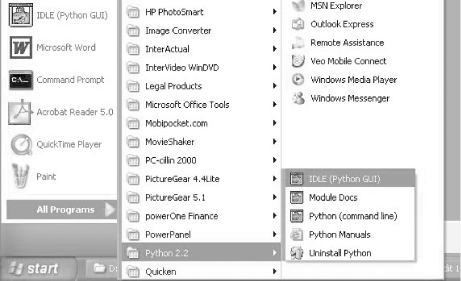2.1 Introducing the Python Interpreter
| So far, we've mostly been talking about Python as a programming language. But as currently implemented, it's also a software package called an interpreter. An interpreter is a kind of program that executes other programs. When you write Python programs, the Python interpreter reads your program, and carries out the instructions it contains. In effect, the interpreter is a layer of software logic between your code and the computer hardware on your machine. When the Python package is installed on your machine, it generates a number of components minimally, an interpreter and a support library. Depending on how you use it, the Python interpreter may take the form of an executable program, or a set of libraries linked into another program. Depending on which flavor of Python you run, the interpreter itself may be implemented as a C program, a set of Java classes, or other. Whatever form it takes, the Python code you write must always be run by this interpreter. And to do that, you must first install a Python interpreter on your computer. Python installation details vary per platform, and are covered in depth in Appendix A. In short:
Python itself may be fetched from the downloads page at Python's web site, www.python.org. It may also be found through various other distribution channels. You may have Python already available on your machine, especially on Linux and Unix. If you're working on Windows, you'll usually find Python in the Start menu, as captured in Figure 2-1 (we'll learn what these menu items mean in a moment). On Unix and Linux, Python probably lives in your /usr directory tree. Figure 2-1. Python on the Windows Start menu Because installation details are so platform-specific, we'll finesse the rest of this story here. (For more details on the installation process, consult Appendix A.) For the purposes of this chapter and the next, we'll assume that you've got Python ready to go. |
EAN: 2147483647
Pages: 253